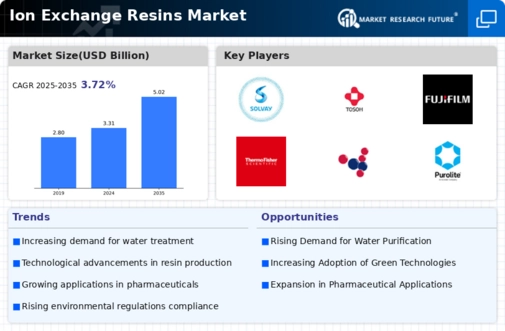Top Industry Leaders in the Ion Exchange Resins Market

The global ion exchange resins market, boasts steady growth driven by diverse applications in water treatment, pharmaceuticals, and industrial processes. This dynamic landscape is characterized by fierce competition, with established players and innovative newcomers vying for market share. Let's delve into this market's competitive arena, exploring key strategies, market share factors, industry news, and recent developments.
Ion Exchange Resins Market Strategies Adopted by Market Leaders:
-
Product Diversification: Major players like Purolite, Lanxess, and DuPont are expanding their portfolios beyond traditional cation and anion exchange resins, developing high-performance specialty resins for niche applications in hydrometallurgy, electronics, and bioseparations. -
Regional Expansion: Established companies are focusing on emerging markets like China and India, where rising demand for clean water and industrial development offers significant growth potential. Acquisitions and strategic partnerships are common tactics to gain local footholds and distribution networks. -
Technological Advancements: Continuous R&D efforts are directed at developing resins with improved efficiency, selectivity, and regeneration capabilities. Sustainability is also a key focus, with the development of bio-based resins and resin recycling processes gaining traction. -
Customer-Centric Approach: Providing customized solutions and technical support is crucial in a market with diverse needs. Leading companies are investing in application labs and customer service teams to cater to specific industry requirements and optimize resin performance.
Factors Influencing Market Share:
-
Product Quality and Performance: Consistent product quality and performance reliability are paramount for gaining customer trust and repeat business. Stringent quality control measures and certifications play a crucial role. -
Brand Recognition: Established brands with a proven track record often hold an advantage in terms of customer preference. However, innovative newcomers can disrupt the market with unique offerings and competitive pricing. -
Cost and Pricing Strategy: Price sensitivity varies across industries, with water treatment applications generally more cost-conscious compared to pharmaceuticals or electronics. Optimizing production costs and offering competitive pricing are crucial for market share gains. -
Geographic Presence: Strong distribution networks and local production facilities in key markets provide a significant advantage in terms of delivery lead times and customer service.
Key Players
- DuPont de Nemours, Inc., (US)
- Lanxess (Germany)
- Purolite Corporation (US)
- Mitsubishi Chemical Corporation (Japan)
- Thermax Limited (India)
- Ion Exchange (India)
- Novasep Holding (France)
- Samyang Corporation (South Korea)
- ResinTech Inc., (US)
- Sunresin New Materials Co., Ltd (China)
- Bio-Rad Laboratories, Inc. (US)
Recent Developments :
September 2023: Lanxess unveils a new generation of high-performance cation exchange resins specifically designed for hydrometallurgical processes, offering enhanced selectivity and regeneration efficiency.
October 2023: DuPont de Nemours, Inc. signs a strategic partnership with a leading water treatment company in India to develop and commercialize customized ion exchange solutions for industrial wastewater treatment applications.
November 2023: The European Union announces stricter regulations for the use of certain chemicals in water treatment processes, prompting increased demand for environmentally friendly ion exchange resins.
December 2023: A major research breakthrough leads to the development of a bio-based ion exchange resin with exceptional adsorption capacity, opening doors for more sustainable water purification technologies.

